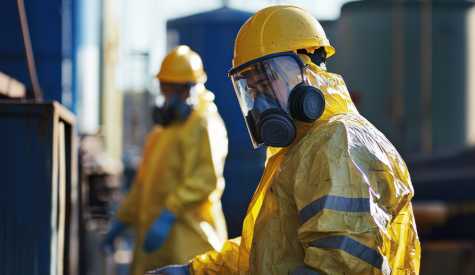Cutting Construction Risks: AI’s Role in Lowering TRIR

Construction sites are dynamic environments, constantly shifting and presenting unique safety challenges. Yet traditional training methods often fail to address the specific risks workers face. The result? Preventable incidents that harm employees, delay projects, and impact a company’s bottom line.
Artificial intelligence (AI) offers a new approach. By analyzing site-specific hazards and historical incident data, AI creates customized learning pathways that prepare workers for the challenges they’ll encounter. In this article, we explore how AI-powered training can help reduce Total Recordable Incident Rates (TRIR), improve compliance, and transform safety in the construction industry.
Challenges in Reducing TRIR in Construction
Total Recordable Incident Rate (TRIR) is a key metric for measuring workplace safety. It calculates the number of recordable incidents per 200,000 worker hours, providing a standardized way to assess risk.
For construction companies, high TRIR can mean more than just increased insurance costs. It attracts regulatory attention, complicates bids for new projects, and tarnishes industry reputation.
However, reducing TRIR in construction isn’t simple. The nature of the work itself poses significant hurdles:
Hazardous Tasks: Tasks like working at heights, trenching, or operating heavy machinery inherently carry risks.
Dynamic Work Environments: Construction sites constantly change, making it difficult to standardize safety measures.
Training Gaps: Generic safety training often fails to address specific site conditions, leaving workers unprepared for unique hazards.
As the risks inherent to construction work continue to evolve, traditional approaches to safety training fall short in addressing the nuances of dynamic worksites. The question is: how can companies go beyond basic training to create safer environments and better protect their workers?
The Role of AI in Safety Training
AI is redefining how safety training is delivered, focusing on precision and adaptability. By using advanced algorithms, AI brings new dimensions of efficiency and effectiveness to workplace safety. Here’s a closer look:
Analyzing Incident Trends
AI systems delve into years of incident reports, near-miss logs, and safety audits to uncover patterns that might otherwise go unnoticed. For example:
Identifying Recurring Risks: An AI system might detect that hand injuries consistently occur during specific tasks, like material handling or tool usage.
Highlighting Seasonal Variations: AI can point out increased risks tied to weather changes, such as heightened slip-and-fall incidents during rainy months.
These insights allow companies to focus on areas that have a proven track record of causing harm, ensuring resources are directed where they are needed most.
Customizing Training
Unlike traditional one-size-fits-all training programs, AI develops highly specific content based on the unique needs of a construction site or project phase. For instance:
Tailored Scenarios: Workers at a high-rise site might receive training on mitigating fall risks, while those at a ground-level site focus on excavation hazards.
Skill-Level Adjustments: AI can modify training content to align with an individual worker’s experience, providing basic overviews for new hires and in-depth modules for seasoned professionals.
By tailoring the training, AI ensures workers are equipped with knowledge that is immediately relevant and actionable. Imagine a construction site implementing AI training after noticing a spike in scaffolding falls. The AI system not only highlights this trend but also generates targeted modules emphasizing fall prevention techniques, proper equipment use, and hazard awareness.
By combining data-driven insights with real-time adaptability, AI provides a practical, effective way to close the gaps in traditional training. But how does this technology create meaningful pathways for safer work environments, especially in high-risk construction tasks?

AI-Powered Learning Pathways in Construction
AI doesn’t just respond to hazards; it actively transforms how safety is managed on construction sites by offering forward-looking, highly customized solutions.
High-Risk Task Training
Certain tasks, like trenching, working at heights, or operating heavy machinery, are statistically more dangerous. AI focuses on these tasks by:
Breaking Down Complex Procedures: Training modules include step-by-step guides, ensuring workers understand every part of a high-risk task.
Simulating Real-World Scenarios: AI can create virtual simulations, allowing workers to practice responding to emergencies in a controlled environment.
This focus ensures that workers entering high-risk zones are better prepared and less likely to experience accidents.
Proactive Hazard Identification
AI doesn’t wait for incidents to occur. Instead, it uses predictive analytics to spot potential risks before they escalate. Examples include:
Weather Monitoring: AI systems might predict increased risks from strong winds that could destabilize scaffolding or cranes.
Worker Behavior Analysis: By analyzing trends like frequent missed safety check-ins, AI can flag potential issues for supervisors to address.
These capabilities provide an extra layer of protection, allowing site managers to take action before hazards become incidents.
The ability to identify risks, predict outcomes, and provide actionable solutions makes AI-powered pathways a game changer for construction safety. But even the best tools need effective implementation, so where can companies turn to bring these innovations to life?
How HSI Can Help
When it comes to improving construction safety, HSI delivers cutting-edge solutions tailored to the unique challenges of dynamic worksites. Our AI-powered learning pathways analyze incident data, assess site-specific risks, and create customized training programs that address the hazards your workers face every day. This targeted approach ensures employees are prepared for real-world challenges, reducing TRIR and boosting safety compliance.
HSI’s platform goes beyond traditional training. With real-time hazard identification, our system proactively adapts as site conditions evolve, ensuring training stays relevant and effective. Supervisors can rely on corrective training recommendations generated by AI to address gaps quickly and prevent incidents before they occur.
Our solutions are scalable, whether you're managing a single project or an international operation. From small businesses to large enterprises, HSI provides the tools to unify safety management, streamline compliance, and enhance safety outcomes across your organization.
It’s time to elevate your safety program with smarter tools and actionable insights. Partner with HSI to create a safer workplace, reduce risks, and drive compliance. Contact us today for a personalized demo and see how HSI’s AI-powered solutions can transform your construction safety strategy.


